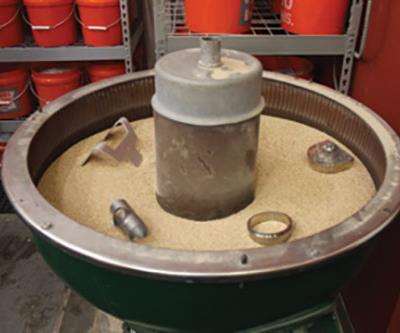Mechanical Finishing Q&A: Mechanical Finishing with Bowl Vibratory Machine
We have heard a lot about other types of vibratory and high energy systems. What is your recommendation for the best machine?
#energy
Q. We use a 3-cubic-foot tub vibratory machine in our finishing department. The tub has produced some good results for uniform finishing and deburring, but we want to invest in a better machine to produce more parts. We have heard a lot about other types of vibratory and high energy systems. What is your recommendation for the best machine?
A. Your parts are machined and the tub vibratory machine is working, but you want to increase your production. For this specification, I would recommend a 10-cubic-foot vibratory bowl machine.
Featured Content
We sell a lot of tubs for first-time inexpensive systems. Parts that need to run within a divided space and parts that are too large for bowls are good tub vibratory projects.
- There are many reasons to use bowl systems:
- They can be built with systems that separate parts/media and unload parts.
- They can be fine-tuned for media aggression, roll and feed.
- They do a good job of keeping parts separated without dividers.
- Larger parts can be hand-unloaded as they run.
Machine parts tend to be larger than 3 to 4 inches square, which can cause part-on-part damage with automatic unloading. These large parts can be easily hand-picked out of the non-unload bowls, as the part and media sweep by the operator. For these reasons, I recommend non-unload bowls for machining operations.
Stampings and sheet metal parts come in various sizes; even large stampings generally do not damage themselves during automatic unloading. I recommend self-unload bowl systems for stamping operations.
High-energy, specialized machines have their applications. Labor reduction in finishing is key, and all mass finishing systems reduce labor in the process. The bowl vibratory systems achieve reduced labor in material handling (unloading) more efficiently than any other mass finishing system.
Originally published in the April 2016 issue.
RELATED CONTENT
-
Automated Electroplating Systems
Simultaneous engineering reduces energy and resource consumption.
-
Putting a Lid on Tanks
KCH Engineered Systems says tank covers reduce overall exhaust requirements, fugitive emissions, heat loss and evaporation rates, energy consumption and calculated surface area for exhaust rates.
-
Aqueous Cleaning Basics
Four factors affect the cleaning process: chemistry; temperature; energy; and time. The various combinations determine how clean your part will be. This article reviews the basics of each type of cleaning to help you determine what will work best for you...



.jpg;width=860)

















